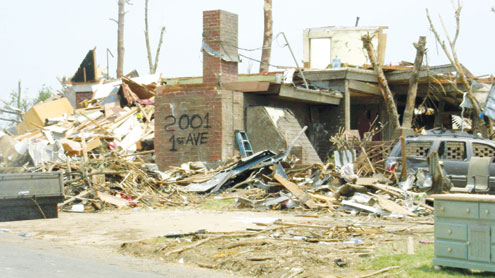 After the tornadoes ravaged Alabama and much of the Southeast early on Jan. 23, residents of the Tuscaloosa area should be prepared to see more severe weather throughout the spring.
After the tornadoes ravaged Alabama and much of the Southeast early on Jan. 23, residents of the Tuscaloosa area should be prepared to see more severe weather throughout the spring.
The United States is currently in a weather pattern known as La Niña. La Niña occurs when the water of the Pacific Ocean is colder than normal, according to local meteorologists Richard Scott, James-Paul Dice and James Spann. This change causes the Southeast to experience a warmer winter, while the Northwest experiences a colder one. Warm weather causes instability in the atmosphere leading to a rise in the likelihood of tornadoes.
The positive or negative phase of the North Atlantic Oscillation is also an important aspect to predicting weather occurrences, Scott, chief meteorologist of Tuscaloosa’s WVUA, said. With a negative NAO, cold weather takes over the eastern half of the U.S. However, since the eastern U.S. is experiencing warmer weather, the NAO is in its positive phase.
Because of the instability of warmer weather, meteorologists suspect that more tornadic activity could be in store for the state of Alabama this year.
“We are now going through an active weather pattern, which is relatively abnormal for this time of year. I expect that the state will slip into spring without even realizing it and, therefore, experience stormy weather and tornadic activity through the next several months,” said Dice, chief meteorologist of Birmingham’s FOX6 WBRC.
However, Spann, chief meteorologist for ABC 33/40 in Birmingham, believes Alabama will go through one more pattern change before the spring conditions are here to stay.
“The winter has certainly been warmer than average, but I fully expect one pattern change later in the season,” Spann said. “It could bring some pretty impressive late-season cold snaps and maybe even a winter storm threat or two.”
With the memories of April 27 still looming over the state, Alabamians should take note that not one singular devastating storm is projected to occur this year.
“If you look through history, this year’s weather pattern resembles the early severe weather of 2008,” Dice said. “I don’t think we will have a single event, but rather a series of smaller storms.”
Although tornados seem prevalent in the Tuscaloosa area, the city’s risk of being damaged by a tornado for a second time has not changed solely based on the fact that it has been hit before.
“There is no increased or decreased chance of a tornado hitting the same spot twice. It’s random,” Scott said. “The atmosphere doesn’t know statistics, so a tornado could hit the same spot four times in one season or one time in 100 years.”
Alabama’s meteorologists are fairly certain in their prediction that the state is headed towards a tumultuous spring, but the inconsistency of weather leaves a margin of error.
“No one out there can say this will continue,” Scott said. “The atmosphere is very complicated and can change in an instant. We try out best to figure out what’s going to happen next, but we get stomped sometimes.”
Although the prediction is not certain, all meteorologists agree that students need to be more conscious of the weather.
“Young adults need to be more connected with what is going on around them,” Dice said. “Whether they get their information through the television, Internet or social media, students need to be more weather-aware.”
Technology, such as the smart phone app iMapWeather Radio, uses a GPS to alert someone who is in a tornado warning polygon. The meteorologists suggest that students invest in this product and take other steps to prepare for severe weather.
“I wish people took tornado warnings more seriously,” Scott said. “They are deadly and can change path and strength in an instant.”







